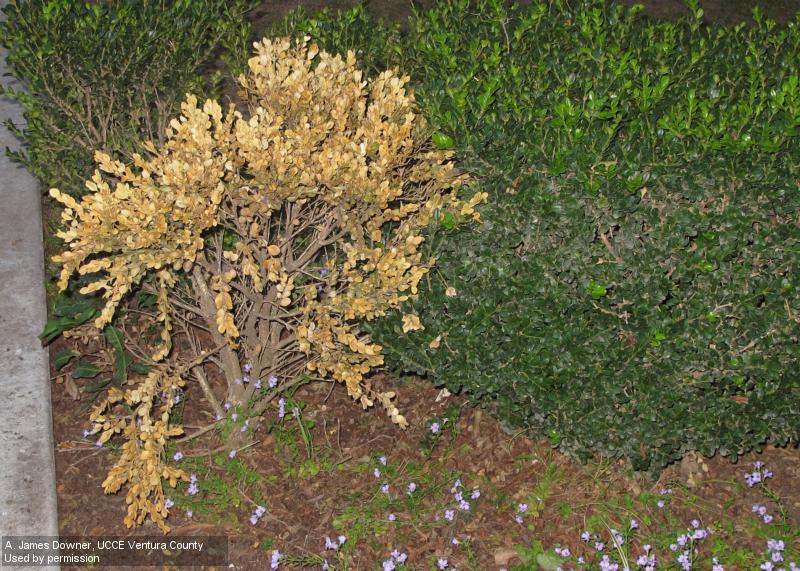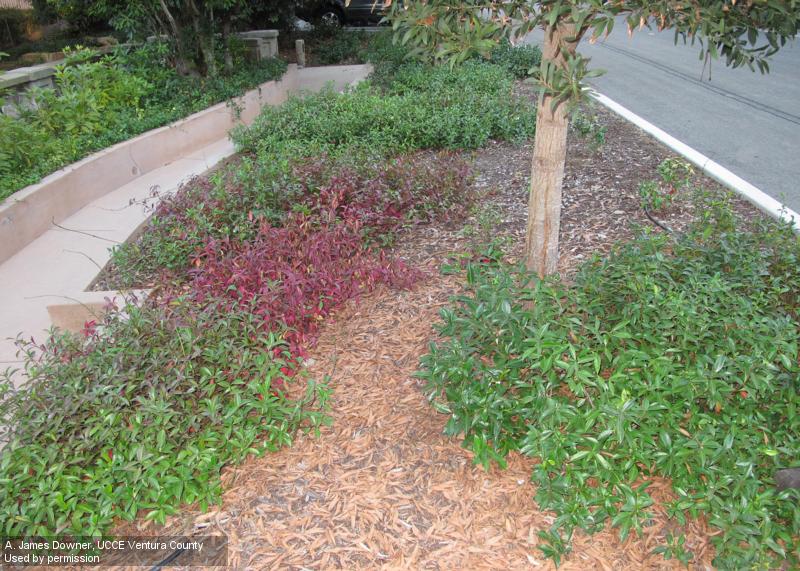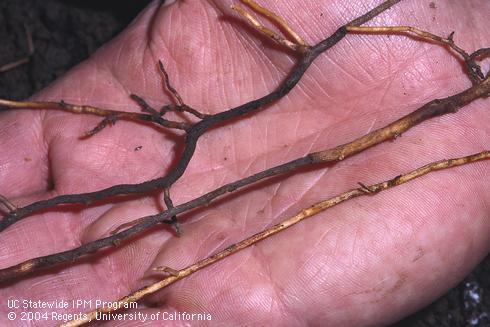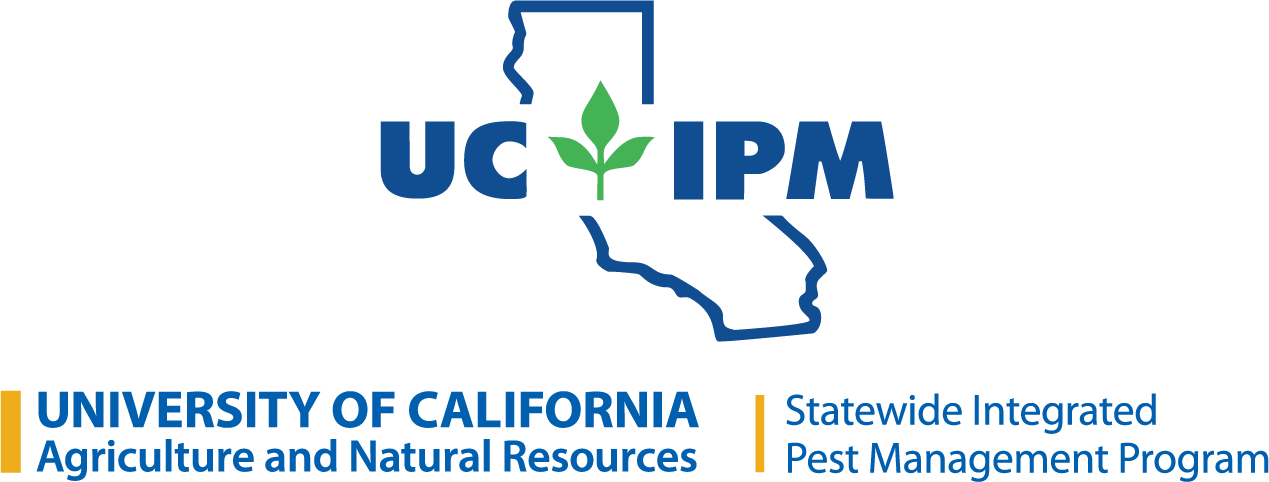Quick Tips
When well-watered trees or other plants start to wilt, one cause may be Phytophthora root and crown rot a soilborne plant disease. Almost all fruit and nut trees and most ornamental trees and shrubs can develop root or crown rot if the soil around the plant remains wet for prolonged periods. Tomatoes, peppers, eggplant, and other vegetable crops also can be affected. The most important way to prevent Phytophthora root and crown rot is proper irrigation.
Overall Symptoms
- Leaves may wilt and turn dull green, yellow, red, or purplish.
- Generally, plants in the most poorly drained areas are affected.
- Unlike plants suffering from water stress, plants don't recover when irrigated.
Symptoms on Roots and Crowns
- Darkened areas in the bark around the crown and upper roots often develop, sometimes with gumming.
- Reddish-brown streaks or zones might be seen in the inner bark and outer layer of wood.
- In tomatoes and eggplants, roots develop water-soaked spots that turn brown, and roots may be rotted off.
- If mushrooms are present or fungal filaments are visible within plants, damage is likely due to a fungal disease such as Armillaria root rot, not Phytophthora.
Water Management Is Key to Preventing Rot.
- Avoid prolonged soil saturation or standing water around tree bases.
- Adjust sprinkler heads and drip systems so water doesn't hit trunks.
- Provide good soil drainage.
- Raised beds can be a good solution for vegetables where drainage is a problem.
- Group plants by irrigation needs and water accordingly.
- Time irrigations to avoid plants becoming water-stressed.
Take Steps to Avoid Problems When You Plant.
- Don't plant trees or other plants deeper than they were planted in the nursery, and never cover the graft union with soil or mulch.
- Select certified nursery stock and resistant rootstocks or varieties when available.
- Try not to have irrigated turfgrass around the base of trees.
- If Phytophthora has been a problem on tomatoes, plant a nonsusceptible crop such as sweet corn in its place for a year or two.
Trees Can Sometimes Be Saved If Rot Is Caught Early.
- At the first sign of leaf wilting, examine the tree at the soil line for rot.
- Cut away any bark that looks affected.
- Remove soil from around the base of the tree down to the top of the main roots and allow the crown tissue to dry out.
- Keep water away from the crown and trunk by only watering at the dripline, the area underneath the canopy.
- Young infected trees may die rapidly; older trees may survive for several years.
Download a PDF of this Quick Tips. Descargue un PDF de estos Notas Breves.
Pest Notes: Introduction
Several species of soilborne pathogens in the genus Phytophthora cause root and crown rot (sometimes called collar rot) diseases of herbaceous and woody plants. Almost all fruit and nut trees, as well as many ornamental trees and shrubs (including many California natives), can develop Phytophthora root or crown rot if the soil around the base of the plant remains wet for prolonged periods, or when planted too deeply. Tomatoes, peppers, eggplant and other vegetable plants can also be affected by Phytophthora root rot.
Different species of Phytophthora attack different plants, and sometimes a single plant can be infected by multiple Phytophthora species. Most Phytophthora species are soil-borne, and are active in warm, moist soils. However, some species prefer cool conditions, developing mostly in wintertime.
These pathogens kill trees and shrubs by growing from the roots up through the root crown and into the lower trunk, where they kill the inner bark and cause browning of the outer layer of sapwood. In herbaceous plants, the process is the same in that the pathogens grow from the roots into the main stem. The stem then collapses, and the entire plant dies. Losses to Phytophthora are minimized by providing good soil drainage, appropriate irrigation, managing plant stress and soil salinity, and selecting resistant plants or varieties.
Other species of Phytophthora spread aerially through wind-driven rain and infect leaves, stems, or fruit of host plants. Examples include Phytophthora ramorum, which causes sudden oak death, and Phytophthora infestans, which causes late blight of tomato and potato. Aerially spread Phytophthora species have very different symptoms and management than the species discussed here. See Pest Notes: Sudden Oak Death. Information about late blight in gardens and landscapes can be found at ipm.ucanr.edu/PMG/GARDEN/VEGES/DISEASES/lateblight.html.

Identification and Biology
The leaves of plants affected by Phytophthora root and crown rot appear drought stressed. Leaves may turn dull green, yellow, or in some cases red or purplish. Trees or plants often wilt and die rapidly with the first warm weather of the season. Often, only plants in the most poorly drained areas of the garden are affected.
Symptoms can develop first on one branch or stem then spread to the rest of a tree or plant. Trees may decline over a period of years before finally dying or may be killed in a single season. A slow decline may occur on vigorous plants that resist disease development, while plants weakened by other diseases or environmental stressors die rapidly. Plants may collapse one at a time among otherwise healthy individuals.
Symptoms on roots and crowns can vary somewhat depending on the species of Phytophthora involved, the plant being attacked, the resistance of the plant variety, and soil moisture and temperature. In general, trees affected by Phytophthora develop darkened areas in the bark around the crown and upper roots.
Gum or dark sap may ooze from the margins of the diseased trunk area, a condition commonly called gummosis. If the surface of infected bark tissue is carefully cut away, reddish brown zones, often separated from healthy tissue by a dark line, can be seen in the inner bark and outer layer of wood. No mycelium (slender filaments of a fungus body) is visible in trees affected by Phytophthora, distinguishing this disease from Armillaria root rot, which is characterized by white mycelial fans between the bark and wood as well as a mushroom odor. For more information about Armillaria root rot, see the Pest Notes.

When tomatoes and eggplants are affected by Phytophthora root rot, roots of all sizes develop water-soaked spots that dry out and turn chocolate brown as the disease progresses.
Damping off, a general term for diseases that kill sprouts and seedlings, can be caused by Phytophthora species, but is more commonly caused by Pythium or Fusarium species. If you have sprouts and seedlings dying, see Pest Notes: Damping-Off Diseases in the Garden. Plants infected just after the seedling stage may suffer a loss of vigor and may later collapse and die. Cutting infected roots in cross section will reveal a brownish discoloration of the conductive tissue’s central core above the lesions. These may extend up into the lower stem.
Phytophthora species are soil-inhabiting pathogens that are favored by wet conditions. Although technically not true fungi (Phytophthora is more closely related to brown algae), they are often referred to as such because they look and behave like fungi. However, there are important differences, including that Phytophthora species are not adequately controlled by most fungicides. Phytophthora species produce resting spores that survive for years in moist soil in the absence of a suitable host. However, resting spore viability declines over time if soils are allowed to dry out.
When a host is nearby and free water (water in soil pore spaces) is present, resting spores germinate to produce spores (zoospores) that swim in water and actively hunt for and infect root tissue. Wounds are not required for infection but may attract swimming spores. Contaminated soil or water, resting spores in decaying host tissue, and infected roots can all be sources for new infections.
The pathogen can be spread in splashing rain or irrigation water, in surface irrigation and runoff water, and by movement of contaminated soil, equipment, or plant parts. Flooded and saturated soil favors the spread of Phytophthora to healthy plants.
While we have lumped most soilborne Phytophthora species together for convenience, it is important to note that different species thrive under different conditions, and therefore effective treatment may require species identification. Warm-season Phytophthora species such as P. cinnamomi, P. citricola, and P. cactorum are typically native to areas with summer rainfall and attack plants when soils are warm and moist. This is particularly problematic for summer-irrigated plants native to Mediterranean regions that may not be adapted to summer rainfall. Cool-season Phytophthora species, such as P. capsici, P. syringae, and P. citrophthora, prefer cool soils and attack plant roots when soils are cool and moist. They are typically a problem in areas with inadequate water drainage in winter. In either case, getting a laboratory determination to species may be useful for determining best management practices, however this is not critical.
Symptoms of Phytophthora root and crown rot are most often seen in spring and early summer when water demand for growth is at its peak or late summer when water stress is at its peak. When dealing with a warm-season Phytophthora species, it is best to let the soil dry out as much as possible between irrigations during the summer. With cool-season Phytophthora species, winter drainage is essential, and it is important to ensure that plantings are not downstream from infested soils.
Management
The most important factor in reducing the development of Phytophthora root and crown rot diseases is appropriate water management. Avoid prolonged saturation of the soil or standing water around the base of trees or other susceptible plants. Without causing undue stress to the plant in question, allow the top few inches of soil to dry thoroughly between watering.
Irrigate only as much and as often as necessary. In a home orchard, keep track of the soil moisture around each tree and water only when necessary. If you irrigate trees with sprinklers, use low-angle sprinkler heads and splitters to avoid wetting the trunk and lower branches. If using a drip system, place the emitters as far as practical from the trunk while still allowing roots access to water. For smaller plants and young trees, this may be within a foot of the trunk or stem, while for mature trees, this distance will be closer to the tree’s dripline (an imaginary line defined by the outer edge of the tree’s canopy). It is critical to remember to adjust the irrigation of newly planted trees as they grow, to move the irrigation out to the edge of the dripline. This must be done annually for at least the first few years, and then as needed until the tree begins to approach its mature size.
Avoid planting susceptible species on poorly drained, compacted, or shallow soils. Water stress, salinity, or both make some plants more susceptible to infection when subsequently wetted by irrigation or rains. Long periods of soaking rain or irrigation reduce the soil oxygen content, making healthy plants susceptible to Phytophthora diseases.
If it is possible to modify site soils, improve soil drainage before planting. When planting perennials such as trees and shrubs, avoid placing organic amendments beneath the root ball as they will decompose, causing the plant to slump and leaving a low area that accumulates excess water. Soils should be well-drained to the rooting depth of the plants, generally 3 to 6 feet for trees, 2 to 4 feet for shrubs, and 1 to 2 feet for bedding plants. It’s important to remember that Phytophthora diseases can develop in as little to 4 to 8 hours of soil saturation.
Increase drainage by breaking through compacted soil layers (hardpan), if present. In poorly drained soils or in an area where you know Phytophthora is present, consider planting trees and shrubs on mounds. The mounds should be 8 to 10 inches high for annuals and up to 2 feet high with a gradual slope for trees and perennials.
Do not install irrigated turf around the base of trees and do not water the crown area directly. Remove all weeds. Never cover the root crown or graft union with soil or mulch. The root crown is the place on a woody plant or annual where the roots emerge from the stem nearest the soil surface. Avoid “volcano mulching” (making piles of mulch around the stems of trees). These increase the incidence of crown rot. Raised beds can improve drainage in a vegetable garden. Group plants according to their irrigation needs. Irrigate only as frequently as plantings require based on seasonal demand or immediate weather changes. Always allow excess irrigation water to drain away before resuming irrigation.
If trees exhibit wilting symptoms when soil moisture should be adequate, examine the tree at the soil line for crown rot. Starting well above the root crown, make a shallow incision into healthy bark, just deep enough to expose the color of the living healthy inner bark. Then make similar shallow incisions every few inches down to the root crown and for the first inch or two down below soil grade. If discoloration of the inner bark is found, carefully cut the outer bark tissue away just enough to determine the extent of the lesion. A plant with a substantial Phytophthora infection rarely recovers. Trees with lesions larger than about one-quarter of the tree’s circumference do not typically recover, even with ideal care. Trees with smaller lesions can sometimes be saved by removing soil from the base of the tree down to the top of the main roots and allowing the crown tissue to dry out. If the root crown is intact without symptoms, examine the fine root system for symptoms of feeder root rot which can lead to similar above-ground symptoms, such as wilting..

Sanitation
It may be possible to slow the spread of Phytophthora within a garden by avoiding movement of infested soil, water, and plant parts from an area where Phytophthora root or crown rot has developed. Surface and subsurface drainage water and anything that can move moist soil can carry the pathogen to a new area, including water flow, boots, car tires, animals, and tools. If the physical setting allows drainage water to flow from infested to uninfected areas within the garden during wet weather, consider redirecting runoff to channel the water away from healthy plants.
Selection of planting stock
When purchasing from nurseries, inspect and choose plants carefully. Slip plants from their pots before purchase to examine the root system. Avoid plants that are severely pot-bound, or with brown roots on the outside of the root ball.
Rotation
If tomatoes, bedding plants, or other annuals have been affected by Phytophthora root rot, avoid planting them or other susceptible plants, such as eggplant or peppers, in the same soil for at least 1 or 2 seasons. Plant resistant vegetable or flowering plants instead or leave the soil unplanted and do not irrigate but keep it well worked to allow the soil to dry as deeply as possible.
Mulching
Mulching with fresh tree trimming chips as well as applying gypsum to the mulched area can work as part of an integrated approach to limiting Phytophthora diseases. Soils high in organic matter, especially from undecomposed sources such as fresh tree trimmings and mulches, can create a Phytophthora-suppressive soil high in organisms that can biologically control Phytophthora species. Biological control is the regulation of a pathogen by organisms that parasitize, eat, or outcompete the pathogen for resources. The enzymes used by fungi to decompose cellulose in wood chips can also degrade Phytophthora spores. Since mulches also conserve soil moisture, irrigation must be managed carefully as constantly wet conditions are not conducive to biological control organisms. Application of gypsum (calcium sulfate) to the soil as a surface dressing (15-25 pounds per hundred square feet) also controls soil-dwelling Phytophthora and can be used as a component of an integrated control program. Calcium ions in gypsum interrupt swimming spores and their ability to infect roots.
Chemical control
The most effective way of preventing Phytophthora root and crown rot diseases is to provide good drainage and to practice good water management. Along with the appropriate cultural controls, the pesticide fosetyl-al (Aliette) or any of the phosphorous acid-based pesticides may be used on several ornamental plant species to help prevent Phytophthora infections. When applied as a foliar spray, it is absorbed by foliage and moves into the roots. Products containing mefenoxam are also registered for use in gardens and for woody ornamental species grown in landscape settings. However, do not rely on pesticide applications alone to control Phytophthora root and crown rot diseases.Always carefully follow labeled instructions as some of these products may harm plants if overapplied.
References
Downer AJ, Menge JA, Pond E. 2001. Association of cellulytic enzyme activities in Eucalyptus mulches with biological control of Phytophthora cinnamomi. Phytopathology 91: 847-855.
Dreistadt SH. 2016. Pests of Landscape Trees and Shrubs, 3rd Edition. UC ANR Publication 3359, Oakland, CA.
Flint ML. 2018. Pests of the Garden and Small Farm, 3rd Edition. UC ANR Publication 3332, Oakland, CA.
Messenger BJ, Menge JA, Pond E. 2007. Effects of gypsum soil amendments on avocado growth, soil drainage, and resistance to Phytophthora cinnamomi. Plant Disease 84: 612-616.
Perry EJ, JJ Farrar. 2024. Pest Notes: Damping Off Diseases in the Garden. UC ANR Publication 74132, Oakland. CA.
Resources
- About Pest Notes
- Glossary
- Compare Risks from Pesticides Mentioned
- WARNING ON THE USE OF PESTICIDES
- List of other Pest Notes


